Homey and satisfying, sourdough biscuits made with sourdough discard are rich and buttery with a subtle sourdough tang and tender, flaky texture. Choose round cut biscuits or skillet drop biscuits and make these quick last minute biscuits today!
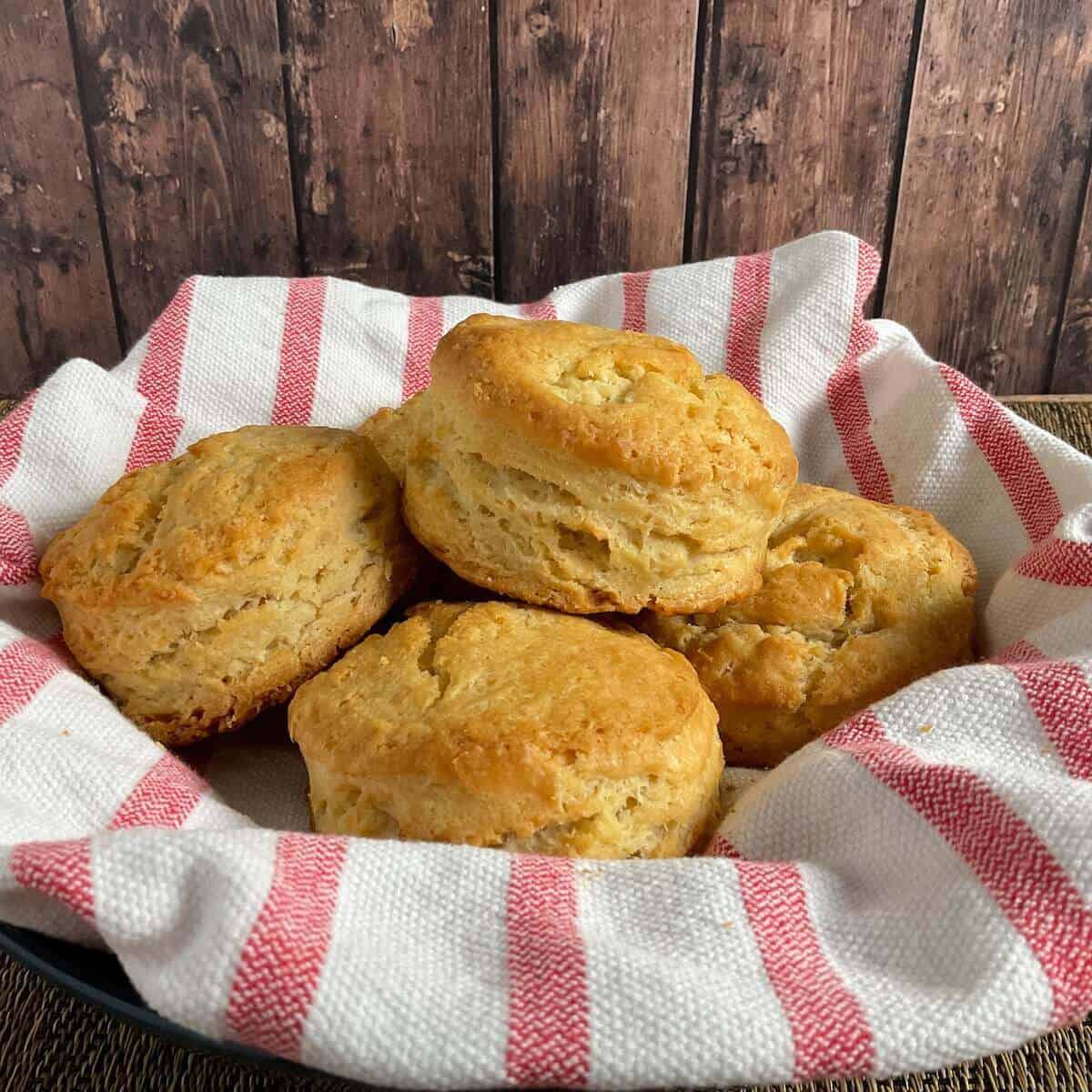
Jump to:
[October, 2022: I've reworked the recipe and updated this post with all new pictures. Enjoy!]
Why this recipe works
- You only need 5 ingredients to make a sourdough discard biscuit recipe
- These biscuits get bathed in butter for extra richness, and are made with sourdough starter discard for a subtle tanginess
- Sourdough biscuits are a great last minute side dish because the dough comes together quickly without needing rising time
- This is a great use for your unfed starter
Biscuits are about as homey an item I can think of baking. The dough is quick to make (not like baking bread, which requires time for the dough to rise) so they can be made at the last minute, almost on a whim. And biscuits can even be flavored, like these pumpkin pie biscuits.
When you’re searching for ways to use the discard from feeding sourdough starter, having a recipe for buttery Sourdough Discard Biscuits in your back pocket is handy. They're great for a fast accompaniment to a family dinner…or breakfast…or lunch…or snack. They can be thrown together just before sitting down for a easy Thanksgiving side dish.
Drizzled with honey and slathered with butter or jam, these crumbly bits of portion-controlled bread heaven are comfort food that practically sings of family and home.
Sourdough discard biscuits are rich and buttery, with a subtle sourdough tanginess. The texture is flaky with a pleasing crunch on the outside.
You can serve them with an easy homemade gravy, and they'd taste great next to Southern Baked Chicken served with Sautéed Broccoli With Garlic or on top of Chicken Cobbler!
Recipe Ingredients
You'll need the following ingredients to make this sourdough biscuit recipe:
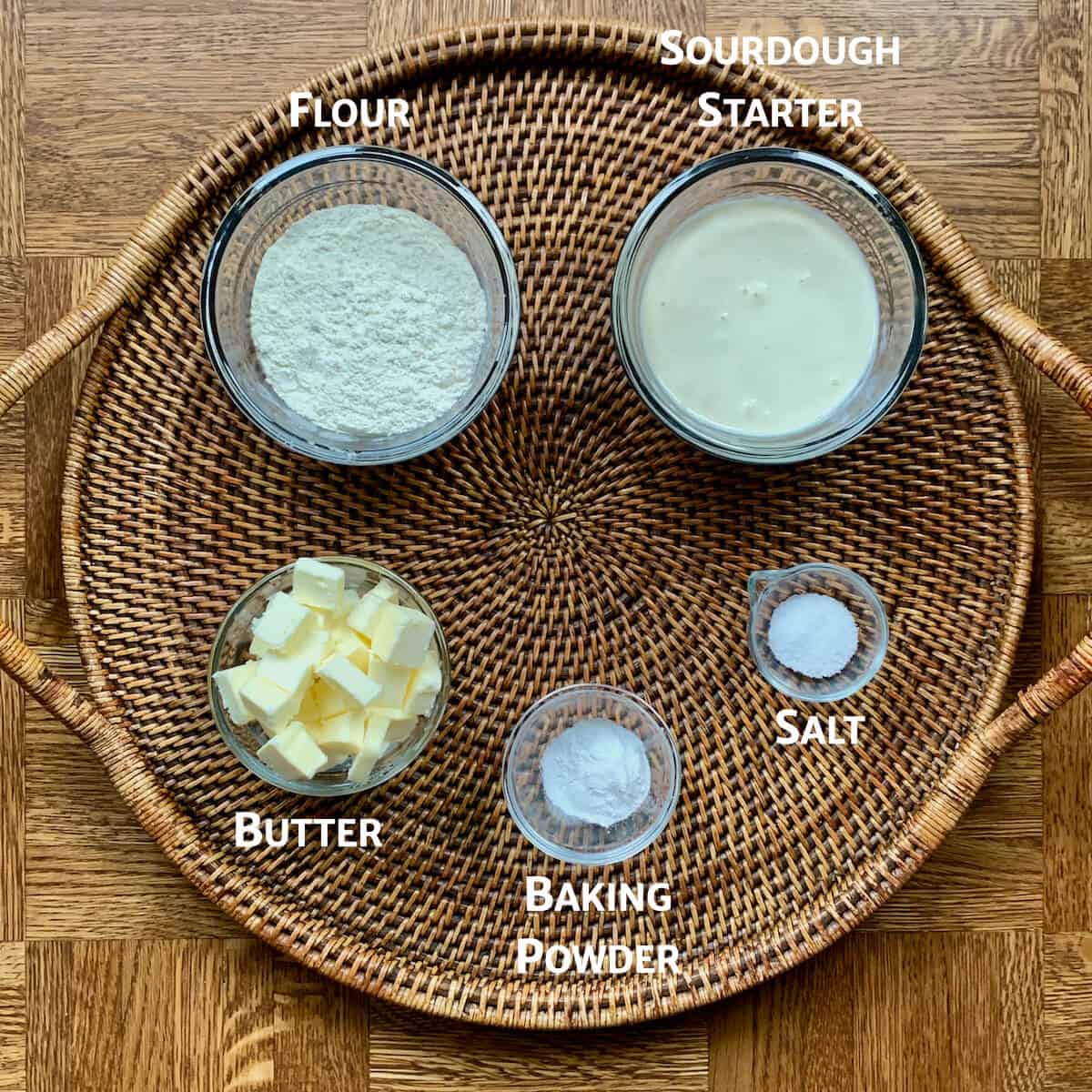
Ingredient Notes
My sourdough biscuit recipe has only five ingredients: flour, sourdough starter discard, baking powder, salt, and butter. The list is very similar to shortcakes and scones.
Although it doesn't seem like it from first glance, the ingredients for sourdough biscuits follow the same 3 : 1 : 2 recipe ratio of 3 parts flour, 1 part fat, 2 parts liquid (by weight) as shortcakes and scones. The difference is the substitution of sourdough discard for the liquid in the recipe.
Sourdough starter discard: I use sourdough starter that is 50% each flour and water, and that starter is fully hydrated, so less overall liquid is required. Since starter discard also contains flour, there is less additional flour needed.
Butter: Make sure your butter is well chilled. You can cut up cold butter from refrigerator, or use frozen, grated butter.
Baking powder: The baking powder helps lift the biscuits - don't leave it out.
Salt: This sourdough biscuit recipe also uses less salt than most traditional biscuit recipes because the sourdough starter discard already has the…er…sour flavor that salt would provide. You can, of course, adjust the salt to your tastes (and the tanginess of your sourdough starter).
See the recipe card for a full list of ingredients and measurements.
How to make sourdough discard biscuits
Step 1: Make the biscuit dough
Whisk together the flour, baking powder, and salt.
Use a pastry blender, two forks, or your hands to work the butter into the flour mixture until coarse, pea-sized crumbs appear (photo 1). Don't overdo this step as you don't want the butter to warm up and mix completely into the flour.
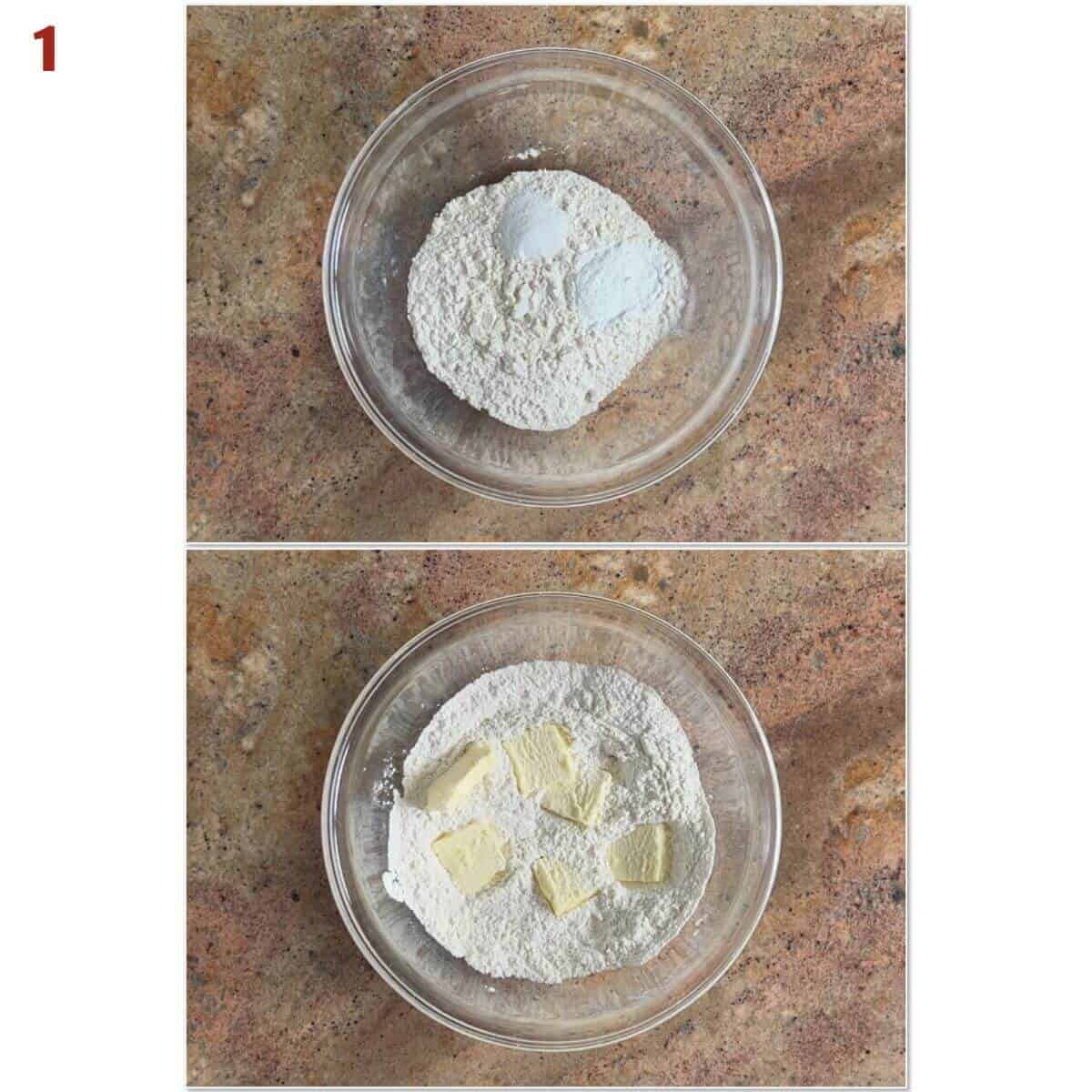
Slowly add the starter discard to the flour mixture and mix until the dough just holds together (photo 2). Using a bowl scraper will help to combine the dough in the bowl without your hands warming up the butter, plus you can see any crumbs at the bottom that still need to be mixed in.
If the dough still looks dry and shaggy after mixing in the sourdough starter, add ice cold water, in 1 tablespoon increments, until the dough holds together.
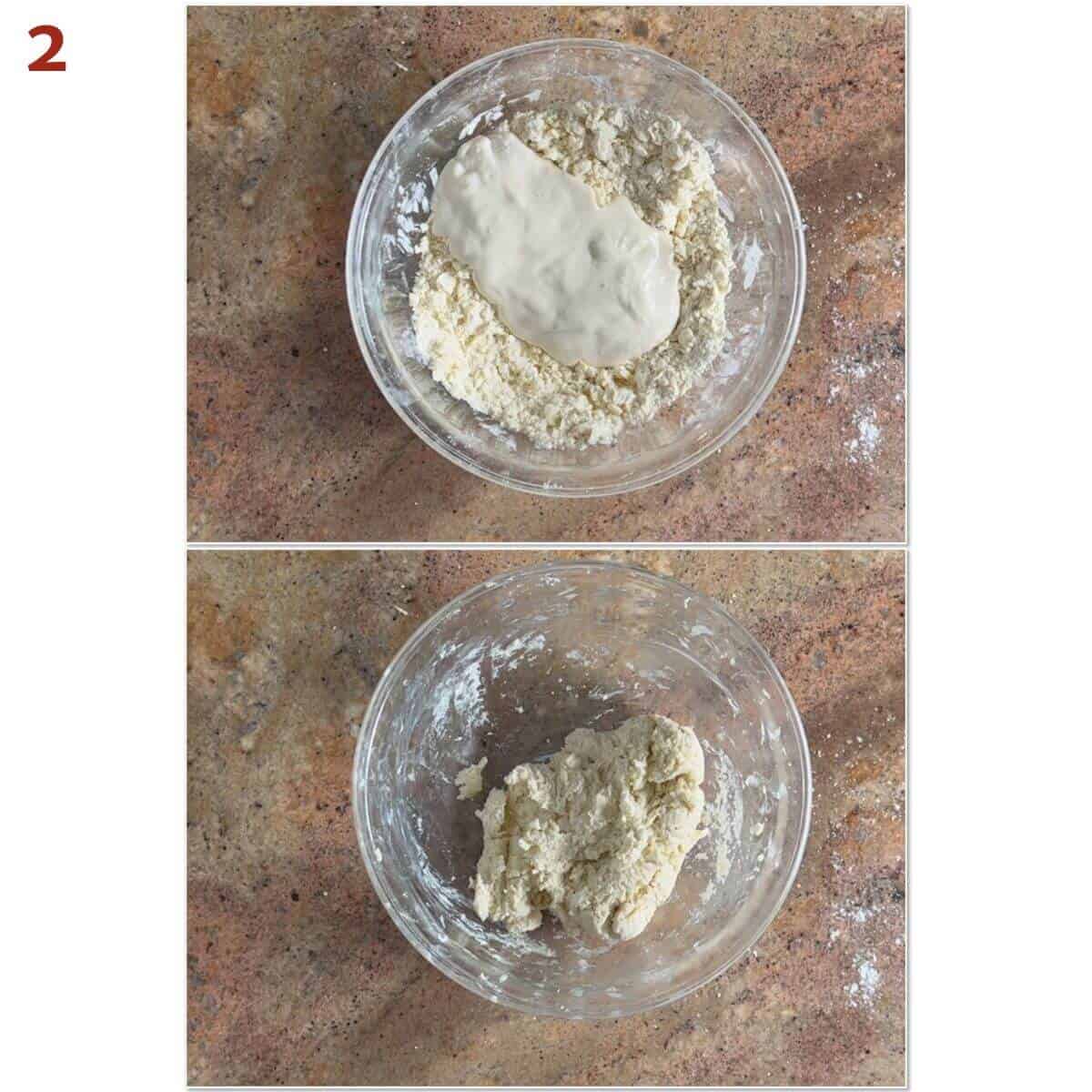
Turn the dough out onto a lightly floured surface, and gently pat it out into a rectangle. Use a bench scraper to fold the dough in half, pressing with the side of the scraper. Turn the dough a quarter turn, then fold again. Repeat the process one more time.
Pat the dough into a ¾-inch thick circle. Cover the dough with plastic wrap, and chill for 15 to 30 minutes (photo 3).
Chilling is optional, but if you have the time, it will let the butter firm up again for a flakier biscuit.
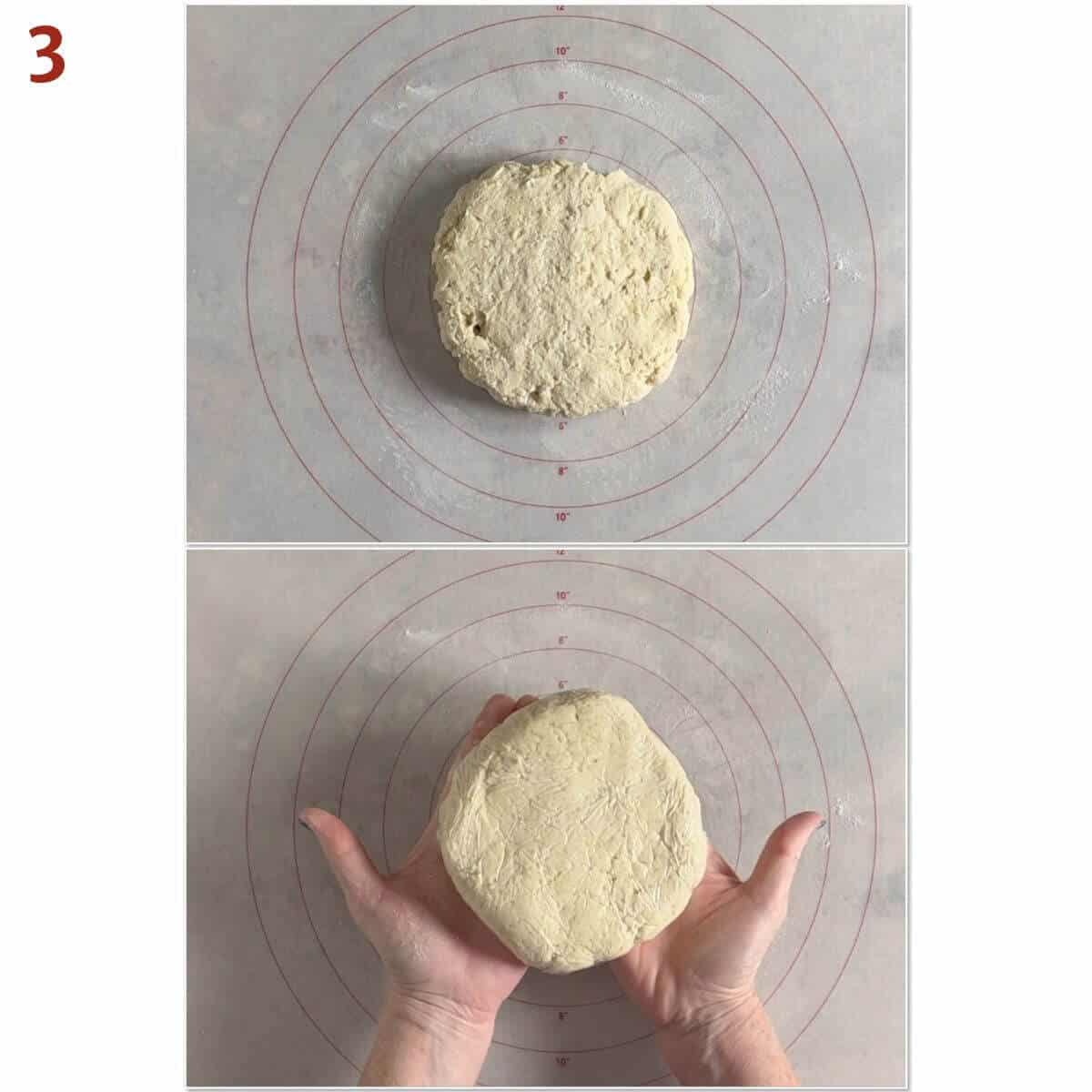
Step 2: Cut out biscuit rounds
Note: If you prefer to make drop biscuits instead of cutting them out, I have instructions for those below.
Unwrap the chilled dough and place it on a lightly floured work surface. Use a 2½-inch round cookie cutter to cut out rounds, cutting them as close to one another as possible (photo 4).
Pat any scraps back together and cut additional biscuits (these may not be as high as the first batch).
Biscuit Cutting Tip
Be sure to press straight down with the cutter. Don't twist or the biscuits won't rise as much. Also, your actual yield will depend on how high you pat the dough disk before cutting. The taller the disk, the less biscuits you'll get out of the batch.
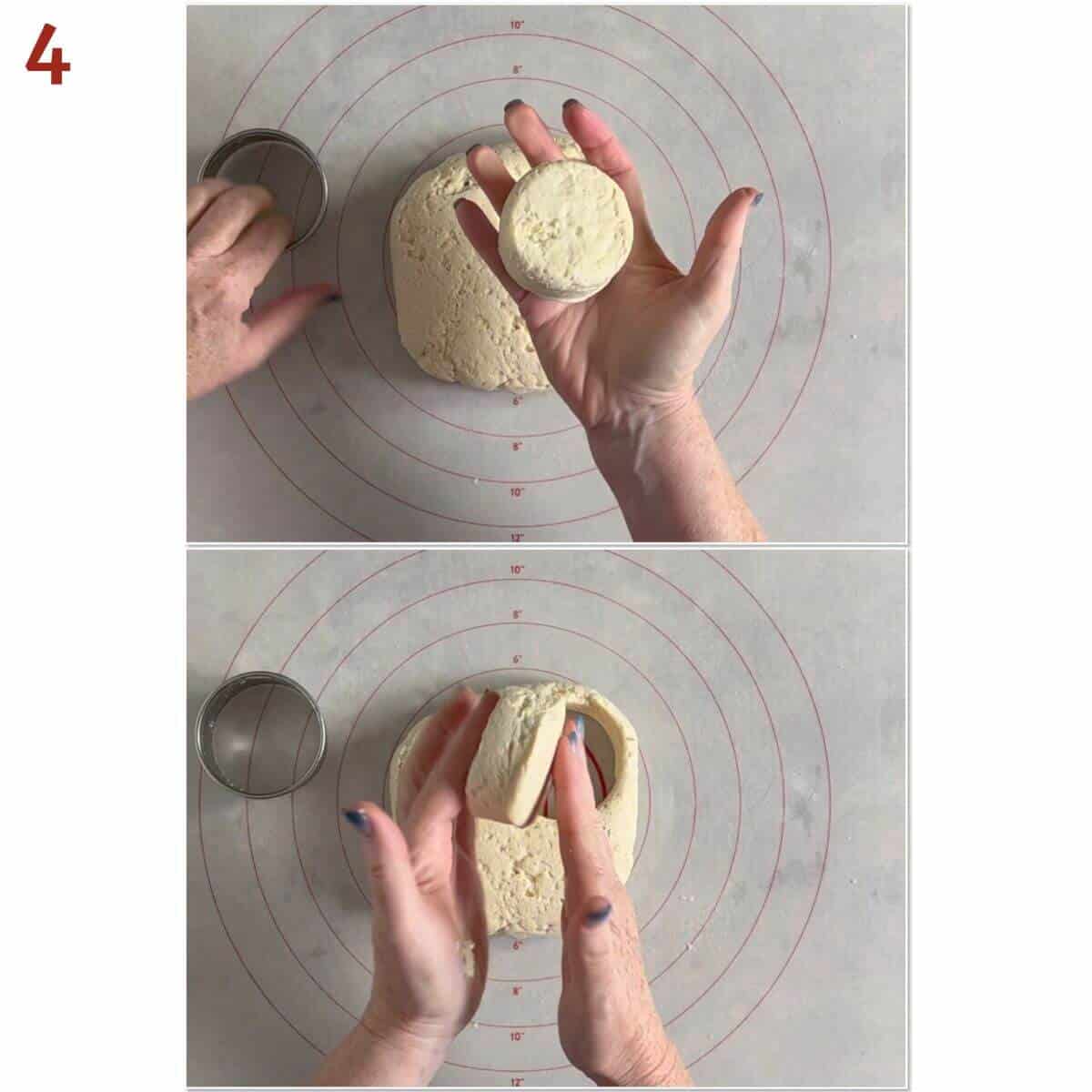
Step 3: Bake the biscuit rounds
Transfer the cut rounds to a half sheet baking pan lined with a Silpat silicone mat or parchment paper. Brush them with melted unsalted butter (photo 5) before they head into the oven.
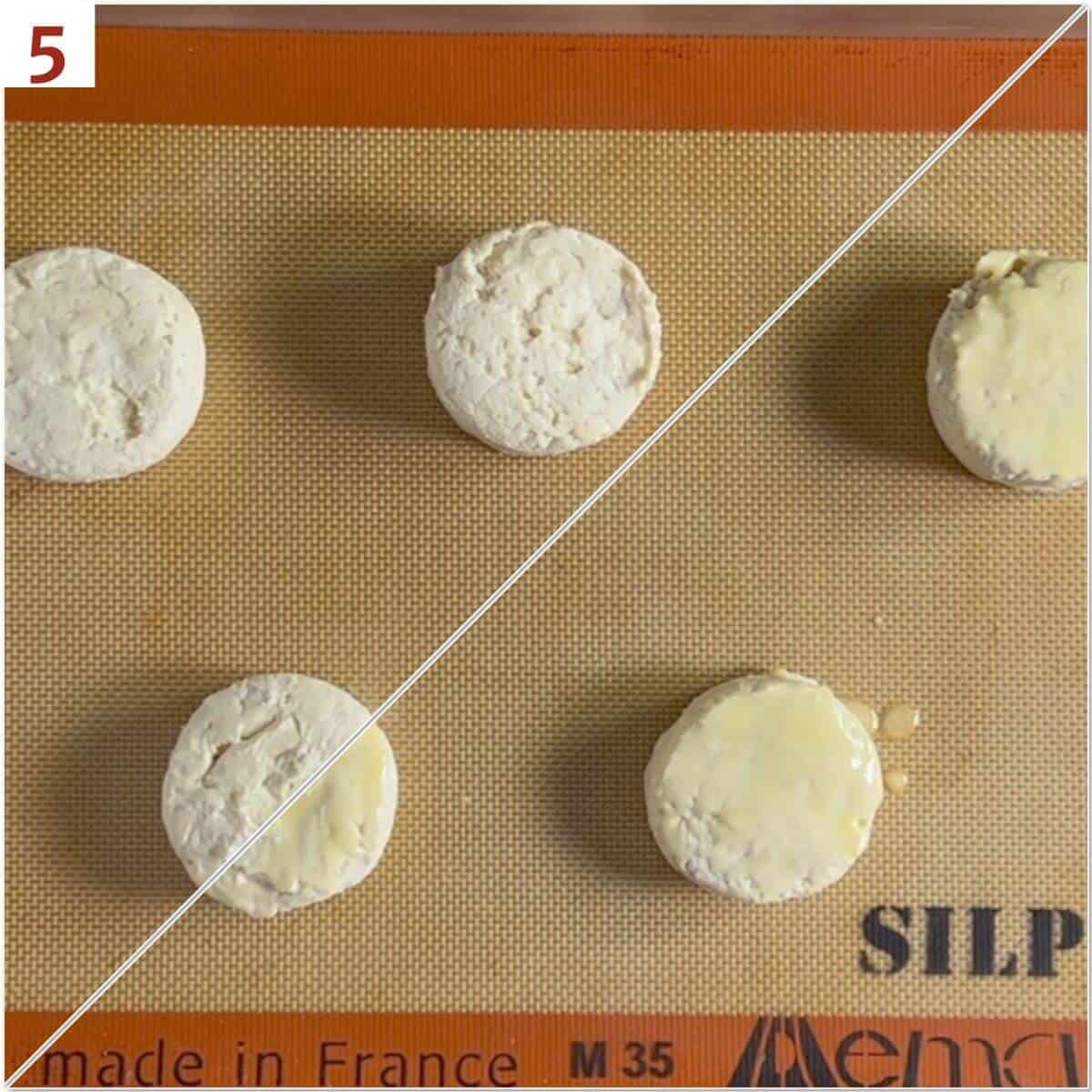
Bake the biscuits at 425˚F for 20 to 23 minutes, or until they're golden brown. Brush the hot biscuits with the remainder of the melted butter for more buttery goodness and serve warm (photo 6).
Don't skip brushing the biscuits with butter before and after baking - this step makes the biscuits go from good to great when you give them a “butter bath.” Just be sure to use unsalted butter so they don't get over-salted.
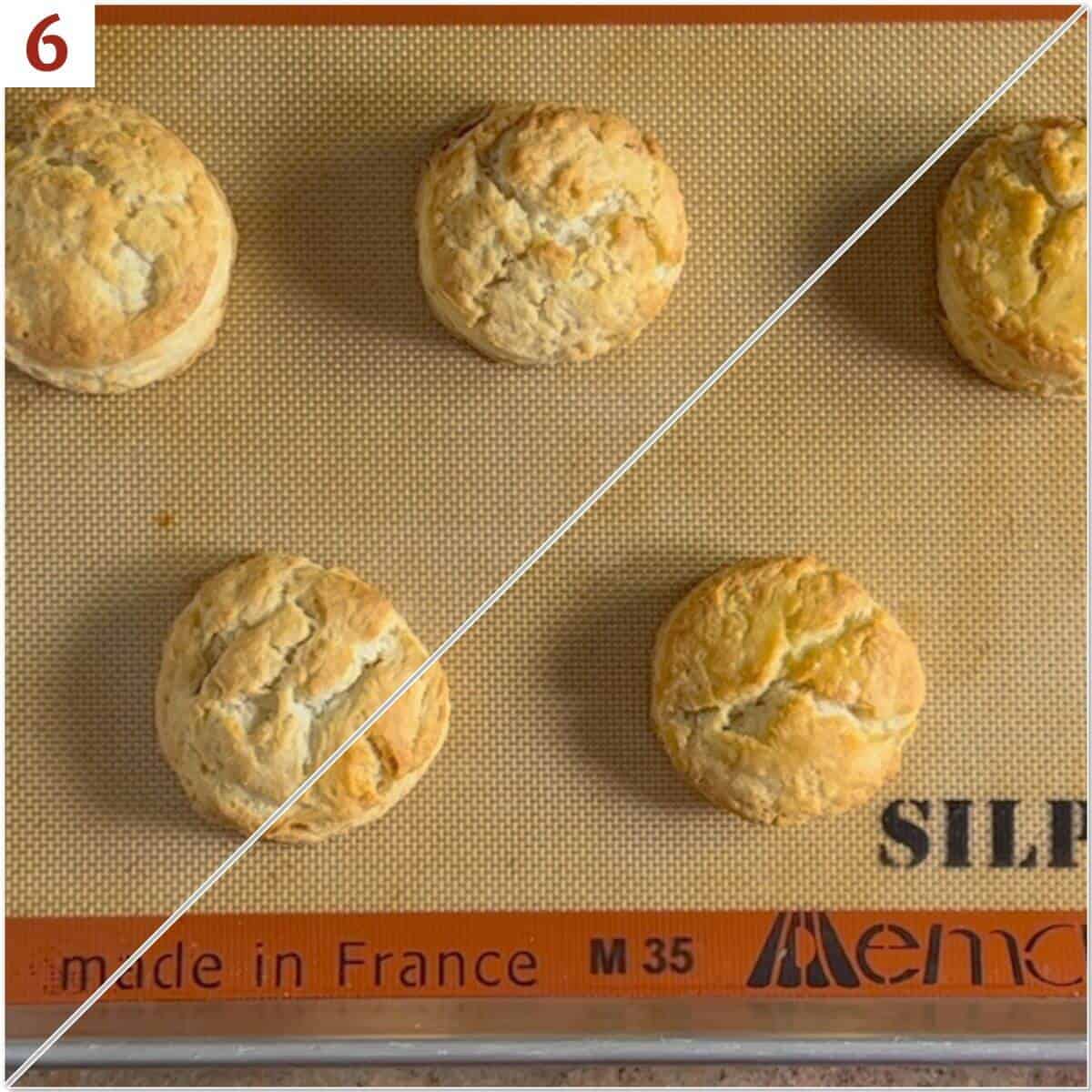
How to make sourdough drop biscuits
If rolling and cutting the biscuit dough seems like too much work, you can make sourdough drop biscuits instead (just know that drop biscuits won't be as tall and flaky as cut biscuits):
- Have a 6½-inch cast iron skillet ready. If desired, put 2 tablespoons of melted butter in the skillet (or spray it with canola oil spray).
- Make the biscuit dough as described above.
- Form the dough into eight egg-sized balls and place in the skillet (it's ok if they're touching). Cover the skillet with a dish towel and let the dough rise for 10 minutes.
- Brush the dough with melted butter, then bake at 425°F for 20 to 25 minutes or until golden brown.
- Brush the biscuits with the remainder of the melted butter and serve warm.
Storage and make-ahead instructions
Storage Instructions: If you're making the biscuits for later, cool them completely on a wire rack, then place in an airtight container and store at room temperature for several days. Rewarm in a 325°F oven for 8 to 10 minutes before serving.
Make-ahead Instructions: To make the dough ahead of time, extend the chilling time of the unbaked disk of dough, so you can make it 2 to 4 days before you need it, then shape and bake it when you're ready.
You can freeze the disk of dough, wrapped with plastic wrap and stored in an airtight bag for up to 3 months. Defrost in the refrigerator until it's just soft enough to portion out. Alternatively, shape your biscuits first, then freeze them in an airtight bag. You can bake off as many as you want without defrosting them first. Just give them a few extra minutes in the oven.
Yield Notes
Your actual yield will depend on how high you pat the dough disk before cutting. The taller the disk, the less biscuits you'll get out of the batch. I usually get between 6 to 8 cut rounds, or 8 dropped biscuits per batch of dough.
Questions asked and answered
Here are some questions you might have...
We're using unfed sourdough starter in these biscuits, which by definition isn't active and bubbly. That means the yeast in the starter isn't going help the dough expand, so you need to use a leavening agent like baking powder or baking soda in the dough.
If you're interested in what happens to your dough when you don't use a leavening agent, I once made that mistake while baking some scones. Check out the FAQs for my basic cream scones to see the results.
You'd be surprised at what you can make from unfed sourdough starter! Some ideas for you are breads like focaccia bread, ciabatta rolls, dinner rolls, and multigrain or rye sandwich bread. Or you might want to try making bagels, soft pretzels, English muffins, and crumpets.
But wait, there are also sweet options for sourdough discard! Gingerbread, spice cake, banana bread, and chocolate chip pumpkin cake are but a few treats you can make with your starter discard. It's great to have so many options for sourdough discard recipes!
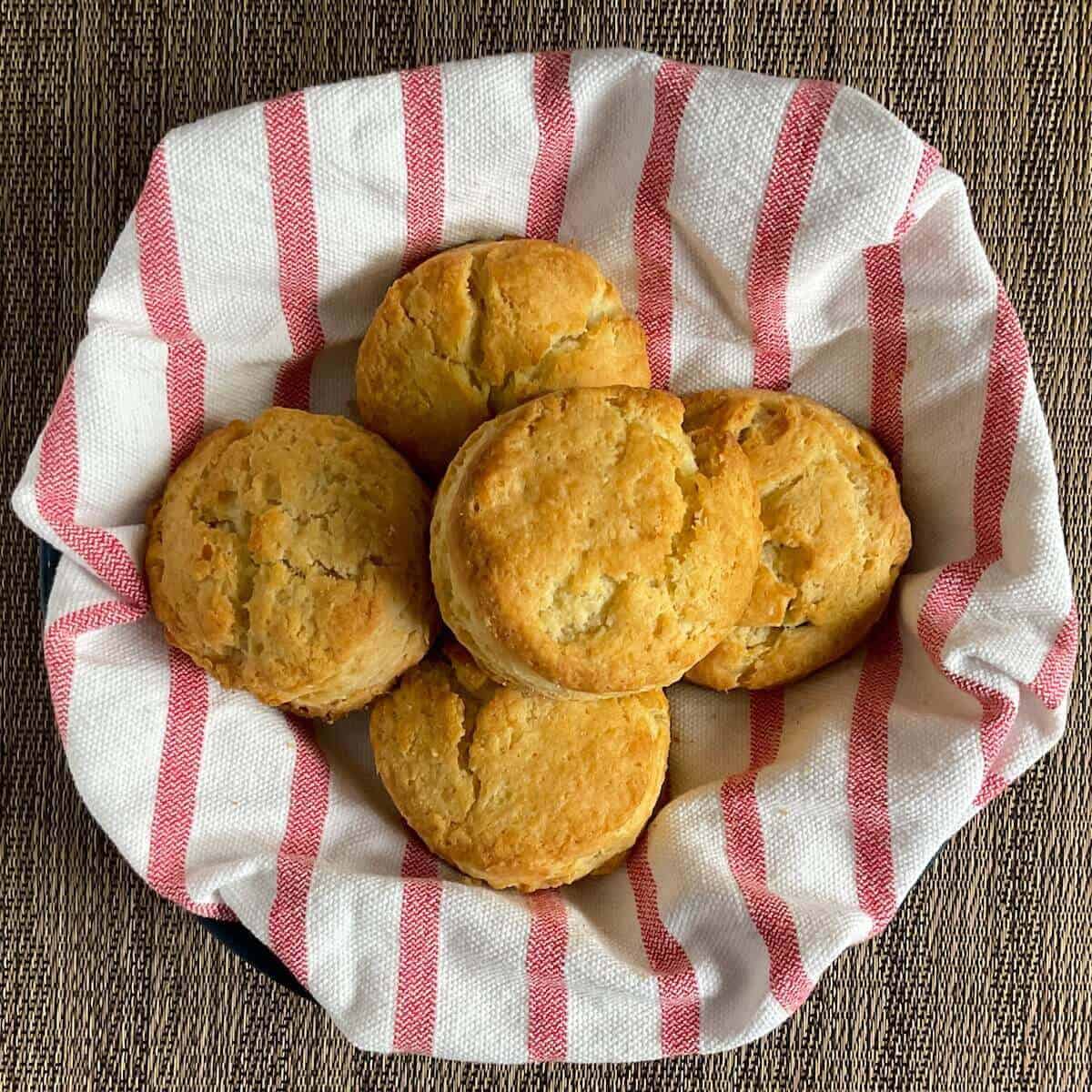
Troubleshooting Tips
I've heard from some readers about the biscuits not rising for them. Cold is key when making biscuits. Here are a few things to consider:
- Be sure that your butter is well chilled: Cutting in frozen, grated butter into the flour works really well, especially since there's not a lot of flour in the dry mixture before adding in the sourdough starter.
- The sourdough starter needs to be well chilled as well: The starter is acting as the cold liquid in this sourdough biscuit recipe. If the unfed starter isn't cold, it can warm the butter as you mix the dough. You should see cold, pea-sized chunks of butter after the dough is mixed.
- If it's a hot day, you might even want to chill the flour before starting the dough.
- If the dough looks dry and shaggy: Like with scones, the humidity of the day will affect the dough's ability to absorb liquid. Squeeze a small amount of dough between your fingers - if the dough still looks dry and shaggy, add ice cold water in 1 tablespoon increments until the dough holds together.
- Folding the dough over after mixing helps to create layers of flour and butter. It's the same method as when you're folding in a mix-in to these chocolate chip scones.
- Chill the dough before baking: You want to keep the butter in the dough cold before the biscuits go into the oven because when the biscuits bake, the steam the water in the butter creates makes the flaky texture that biscuits are known for.
- Limit the number of times you re-roll the dough when cutting: The more you work the dough, the warmer it will become, and the less rise you'll have with those biscuits.
- Press straight down with the cutter: Don't twist as you cut or the biscuits won't rise as much. And any biscuits that aren't cut out won't rise very much at all.
One last note - this sourdough biscuit recipe is based on a sourdough starter with a 100% hydration level (that is, the starter has equal parts of flour and water, by weight). If you use a starter with a different flour to water ratio, that can affect the amount of flour and water you're biscuit dough actually contains, and adjustments might be necessary.
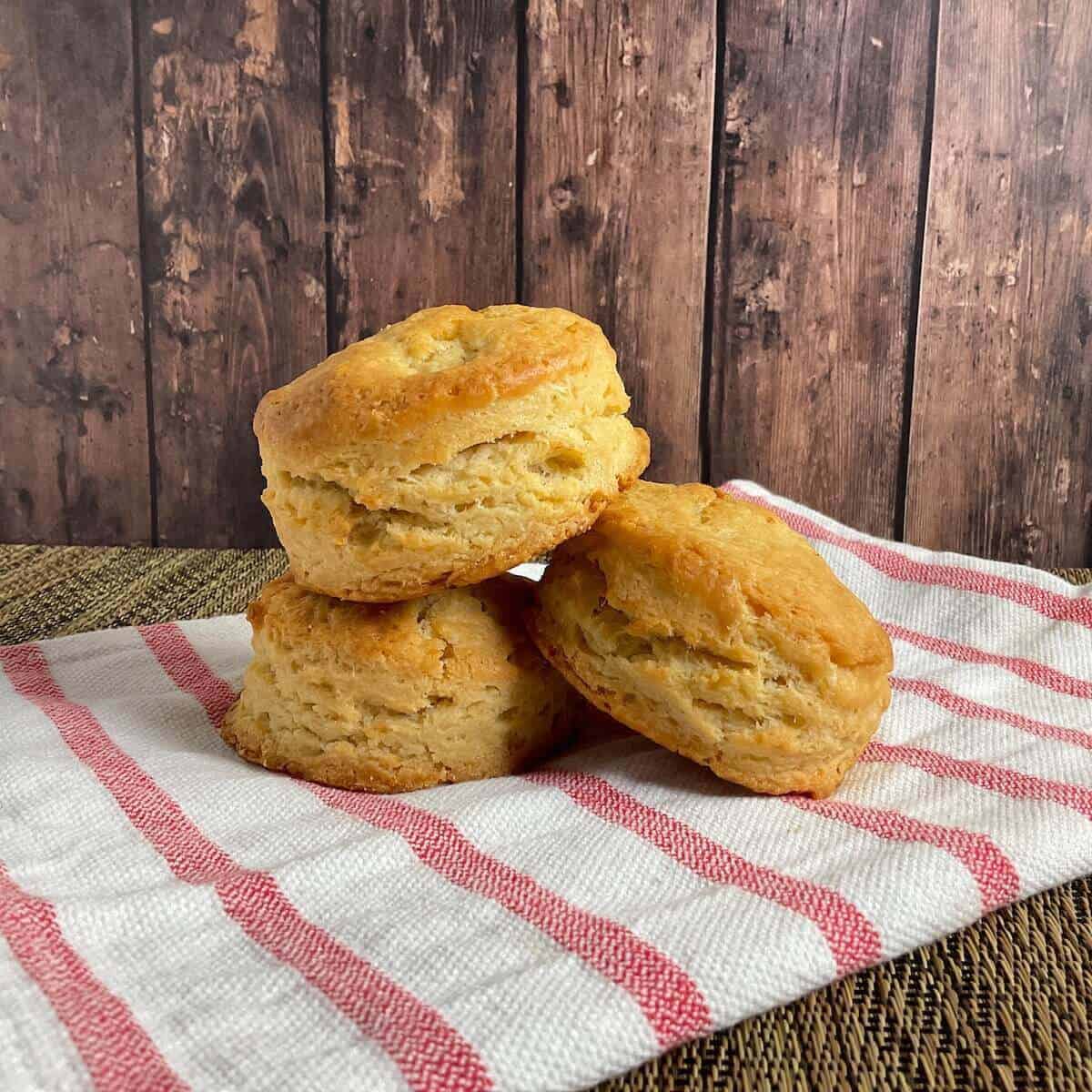
More recipes featuring sourdough discard to try
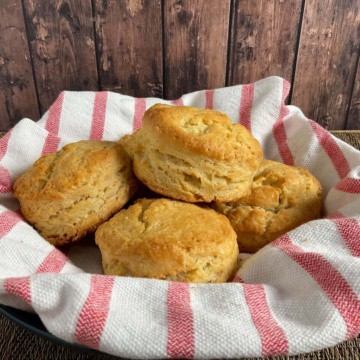
Buttery Sourdough Biscuits
Equipment
Ingredients
For the dough
- 1 cup all-purpose flour
- 1 tablespoon baking powder
- ½ teaspoon kosher salt
- ½ cup unsalted butter, cold, cut into thin slices or frozen and grated
- 1 cup sourdough starter discard, unfed, chilled
For the topping
- 1 to 3 tablespoons unsalted butter, melted
Instructions
- Preheat the oven to 425 °F.
- In a large bowl, whisk together the flour, baking powder, and salt.
- Use a pastry blender, two forks, or your hands to work the butter into the flour mixture until coarse, pea-sized crumbs appear. Don't overdo this step as you don't want the butter to warm up and mix completely into the flour - you should see pieces of butter mixed into the flour.
- Slowly add the starter discard to the flour mixture and mix until the dough just holds together. Using a bowl scraper will help to combine the dough in the bowl without your hands warming up the butter, plus you can see any crumbs at the bottom that still need to be mixed in.The texture of the dough will depend on the humidity of the day. Squeeze a small amount of dough between your fingers - if the dough still looks dry and shaggy, add ice cold water in 1 tablespoon increments until the dough holds together.
- Turn the dough out onto a lightly floured surface, and gently pat it out into a rectangle. Use a bench scraper to fold the dough in half, pressing with the side of the scraper. Turn the dough a quarter turn, then fold again. Repeat the process one more time.
- Pat the dough into a ¾-inch thick circle. Cover the dough with plastic wrap, and chill for 15 to 30 minutes. Chilling is optional, but if you have the time, it will let the butter firm up again for a flakier biscuit.
- Unwrap the chilled dough and place it on a lightly floured work surface. Use a 2½-inch round cookie cutter to cut out rounds, cutting them as close to one another as possible (see the Recipe Notes for how to make skillet drop biscuits).Be sure to press straight down with the cutter - don't twist or the biscuits won't rise as much. Pat any scraps back together and cut additional biscuits (these may not be as high as the first batch).
- Transfer the cut rounds to a half sheet baking pan lined with a Silpat silicone mat or parchment paper. Brush them with melted butter.
- Bake the biscuits for 20 to 23 minutes, or until they're golden brown.
- Brush the hot biscuits with the remainder of the melted butter for more buttery goodness and serve warm.
- Storage Instructions: If you're making the biscuits for later, cool them completely on a wire rack, then place in an airtight container and store at room temperature for several days. Rewarm in a 325 °F oven for 8 to 10 minutes before serving.
- Make-ahead Instructions: To make the dough ahead of time, extend the chilling time of the unbaked disk of dough, so you can make it 2 to 4 days before you need it, then shape and bake it when you're ready.You can freeze the disk of dough, wrapped with plastic wrap and stored in an airtight bag for up to 3 months. Defrost in the refrigerator until it's just soft enough to portion out. Alternatively, shape your biscuits first, then freeze them in an airtight bag. You can bake off as many as you want without defrosting them first. Just give them a few extra minutes in the oven.


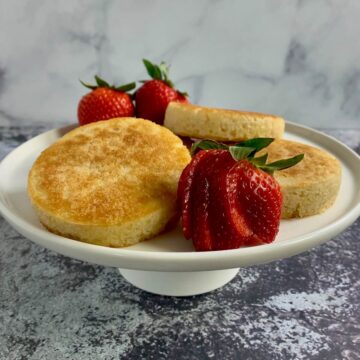

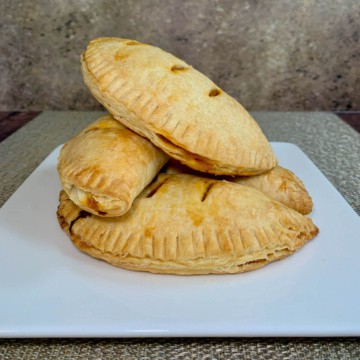
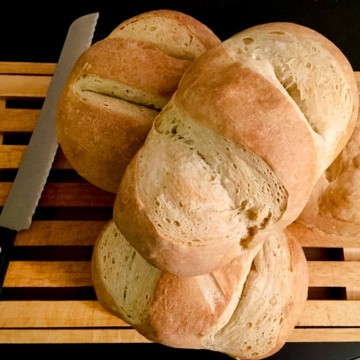
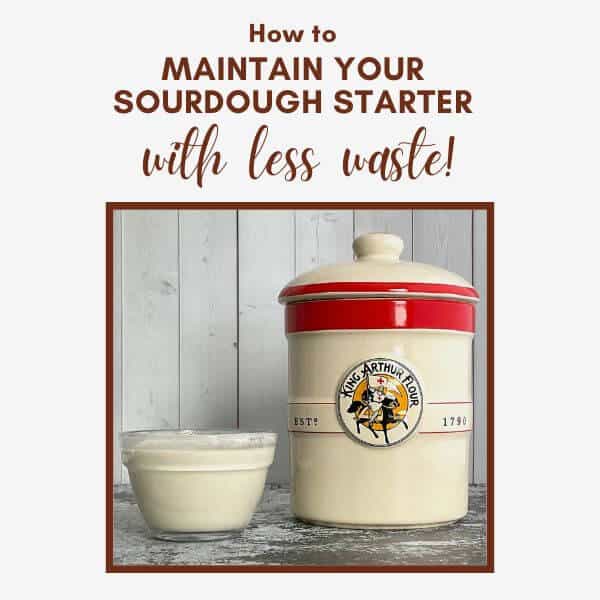


Harple Rosemeryl says
Mine taste good but no rise!
Tammy Spencer says
Hi Harple, I’m sorry this recipe for sourdough biscuits didn’t work for you. In general, the rise will come from two sources: using baking powder and especially using cold butter. It’s the steam evaporating from the chunks of butter that separates the flour into layers during baking. That’s why it’s important to not overwork the dough when you are cutting in the butter. Chilling the dough before baking is also a good idea, allowing the butter to firm up again.
If you let me know your process, perhaps we can troubleshoot to see what went wrong. I’m here to help!
Karyl Lawrence says
These biscuits were very dry and flaky. They didn’t rise. I used baking powder and cold butter. I don’t think I would use this recipe again.
Tammy Spencer says
Hi Karyl, I'm sorry these biscuits didn't meet your expectations. If your dough was too dry (it wouldn't hold together when squeezed), that could lead to dry biscuits. You may have needed another tablespoon or 2 of cold water mixed into the dough. This can happen if the humidity of the day is very low (which can happen in cold temperatures).
After I received your comment, I updated the post to include a few troubleshooting tips. If none of them apply to you, let me know your process so we can troubleshoot further to see what went wrong. I’m here to help!